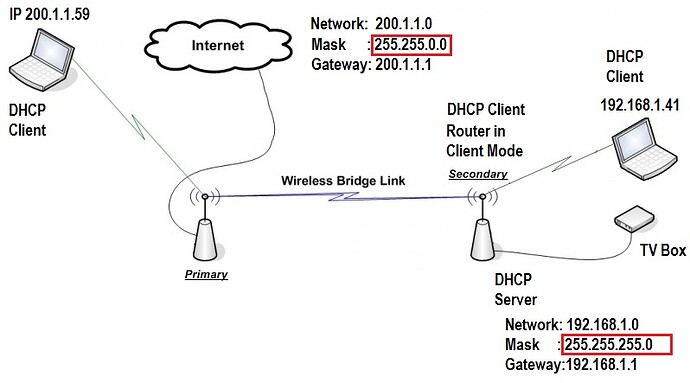Thanks
Maybe best I start over, it is a group of residential buildings, network access is provided by hotspots from kit around the estate. I have no access to that kit, the kit is controlled by an ISP and implemented as a CGNAT (remember I am an OpenWRT newbie so please do not assume I know what I am talking about).
Users see a wifi radio and connect to it using say a windows laptop and get an IP in the 100.x.x.x range, but the signal strength is awful, so putting in a router as a repeater / access point improves things.
I can see on the OpenWRT status screen that the 100 subnet IP is delivered to the router as follows (The 100. IP changes at random times when a new login is required).
IPv4 Upstream
Protocol: DHCP client
Address: 100.59.172.164/16
Gateway: 100.59.0.1
DNS 1: 192.168.55.55
DNS 2: 192.168.66.66
Expires: 0h 3m 12s
Connected: 0h 56m 48s
However from the device you cannot connect to the internet. Looking at the router
Normally going to any website would take you to a login screen on a url like this
https://www.examplewifi.com:8443/home
Even if you go to the appropriate URL you get
This site can’t be reached
www.example.com’s server IP address could not be found.
Try:
Checking the connection
Checking the proxy, firewall, and DNS configuration
Running Windows Network Diagnostics
ERR_NAME_NOT_RESOLVED
In Windows the Ipconfig shows
Ethernet adapter Local Area Connection:
Connection-specific DNS Suffix . : lan
IPv4 Address. . . . . . . . . . . : 192.168.1.185
Subnet Mask . . . . . . . . . . . : 255.255.255.0
Default Gateway . . . . . . . . . : 192.168.1.1
In Windows a tracerout to 8.8.8.8 knows it is Google
Tracing route to dns.google [8.8.8.8]
over a maximum of 30 hops:
1 1 ms <1 ms <1 ms OpenWrt.lan [192.168.1.1]
2 * * * Request timed out.
... repeated until
30 * * * Request timed out.
then on Router Diagnostics
PING openwrt.org (139.59.209.225): 56 data bytes
--- openwrt.org ping statistics ---
5 packets transmitted, 0 packets received, 100% packet loss
Also on Router Diagnostics
Traceroute gives following error on a yellow bar after 30s or so
Error: XHR request timed out
and again on Router Diagnostics
NSLookup seems to work
Server: 127.0.0.1
Address: 127.0.0.1#53
Name: openwrt.org
Address 1: 139.59.209.225
Address 2: 2a03:b0c0:3:d0::1af1:1
Does this give any clues to help diagnose where it is going wrong?



